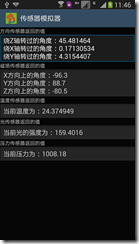main.xml
<?xml version="1.0" encoding="utf-8"?> <LinearLayout xmlns:android="http://schemas.android.com/apk/res/android" android:orientation="vertical" android:layout_width="fill_parent" android:layout_height="fill_parent"> <TextView android:layout_width="fill_parent" android:layout_height="wrap_content" android:text="@string/orientation" /> <EditText android:id="@+id/etOrientation" android:layout_width="fill_parent" android:layout_height="wrap_content" android:editable="false" android:cursorVisible="false" /> <TextView android:layout_width="fill_parent" android:layout_height="wrap_content" android:text="@string/magnetic" /> <EditText android:id="@+id/etMagnetic" android:layout_width="fill_parent" android:layout_height="wrap_content" android:editable="false" android:cursorVisible="false" /> <TextView android:layout_width="fill_parent" android:layout_height="wrap_content" android:text="@string/temperature" /> <EditText android:id="@+id/etTemerature" android:layout_width="fill_parent" android:layout_height="wrap_content" android:editable="false" android:cursorVisible="false" /> <TextView android:layout_width="fill_parent" android:layout_height="wrap_content" android:text="@string/light" /> <EditText android:id="@+id/etLight" android:layout_width="fill_parent" android:layout_height="wrap_content" android:editable="false" android:cursorVisible="false" /> <TextView android:layout_width="fill_parent" android:layout_height="wrap_content" android:text="@string/pressure" /> <EditText android:id="@+id/etPressure" android:layout_width="fill_parent" android:layout_height="wrap_content" android:editable="false" android:cursorVisible="false" /> </LinearLayout>
SensorTest.java
package org.crazyit.sensor; import android.app.Activity; import android.hardware.Sensor; import android.hardware.SensorEvent; import android.hardware.SensorEventListener; //import android.hardware.SensorEvent; //import android.hardware.SensorEventListener; import android.hardware.SensorManager; import android.os.Bundle; import android.widget.EditText; /** * Description: * <br/>site: <a href="http://www.crazyit.org">crazyit.org</a> * <br/>Copyright (C), 2001-2014, Yeeku.H.Lee * <br/>This program is protected by copyright laws. * <br/>Program Name: * <br/>Date: * @author Yeeku.H.Lee kongyeeku@163.com * @version 1.0 */ public class SensorTest extends Activity implements SensorEventListener { // 定义Sensor管理器 private SensorManager mSensorManager; EditText etOrientation; EditText etMagnetic; EditText etTemerature; EditText etLight; EditText etPressure; @Override public void onCreate(Bundle savedInstanceState) { super.onCreate(savedInstanceState); setContentView(R.layout.main); // 获取界面上的EditText组件 etOrientation = (EditText) findViewById(R.id.etOrientation); etMagnetic = (EditText) findViewById(R.id.etMagnetic); etTemerature = (EditText) findViewById(R.id.etTemerature); etLight = (EditText) findViewById(R.id.etLight); etPressure = (EditText) findViewById(R.id.etPressure); // 获取传感器管理服务 mSensorManager = (SensorManager)getSystemService(SENSOR_SERVICE); //① } @Override protected void onResume() { super.onResume(); // 为系统的方向传感器注册监听器 mSensorManager.registerListener(this, mSensorManager.getDefaultSensor(Sensor.TYPE_ORIENTATION), SensorManager.SENSOR_DELAY_GAME); // 为系统的磁场传感器注册监听器 mSensorManager.registerListener(this, mSensorManager.getDefaultSensor(Sensor.TYPE_MAGNETIC_FIELD), SensorManager.SENSOR_DELAY_GAME); // 为系统的温度传感器注册监听器 mSensorManager.registerListener(this, mSensorManager.getDefaultSensor(Sensor.TYPE_AMBIENT_TEMPERATURE), SensorManager.SENSOR_DELAY_GAME); // 为系统的光传感器注册监听器 mSensorManager.registerListener(this, mSensorManager.getDefaultSensor(Sensor.TYPE_LIGHT), SensorManager.SENSOR_DELAY_GAME); // 为系统的压力传感器注册监听器 mSensorManager.registerListener(this, mSensorManager.getDefaultSensor(Sensor.TYPE_PRESSURE), SensorManager.SENSOR_DELAY_GAME); } @Override protected void onStop() { // 程序退出时取消注册传感器监听器 mSensorManager.unregisterListener(this); super.onStop(); } @Override protected void onPause() { // 程序暂停时取消注册传感器监听器 mSensorManager.unregisterListener(this); super.onPause(); } // 以下是实现SensorEventListener接口必须实现的方法 @Override // 当传感器精度改变时回调该方法。 public void onAccuracyChanged(Sensor sensor, int accuracy) { } @Override public void onSensorChanged(SensorEvent event) { float[] values = event.values; // 获取触发event的传感器类型 int sensorType = event.sensor.getType(); StringBuilder sb = null; // 判断是哪个传感器发生改变 switch (sensorType) { // 方向传感器 case Sensor.TYPE_ORIENTATION: sb = new StringBuilder(); sb.append("绕Z轴转过的角度:"); sb.append(values[0]); sb.append(" 绕X轴转过的角度:"); sb.append(values[1]); sb.append(" 绕Y轴转过的角度:"); sb.append(values[2]); etOrientation.setText(sb.toString()); break; // 磁场传感器 case Sensor.TYPE_MAGNETIC_FIELD: sb = new StringBuilder(); sb.append("X方向上的角度:"); sb.append(values[0]); sb.append(" Y方向上的角度:"); sb.append(values[1]); sb.append(" Z方向上的角度:"); sb.append(values[2]); etMagnetic.setText(sb.toString()); break; // 温度传感器 case Sensor.TYPE_AMBIENT_TEMPERATURE: sb = new StringBuilder(); sb.append("当前温度为:"); sb.append(values[0]); etTemerature.setText(sb.toString()); break; // 光传感器 case Sensor.TYPE_LIGHT: sb = new StringBuilder(); sb.append("当前光的强度为:"); sb.append(values[0]); etLight.setText(sb.toString()); break; // 压力传感器 case Sensor.TYPE_PRESSURE: sb = new StringBuilder(); sb.append("当前压力为:"); sb.append(values[0]); etPressure.setText(sb.toString()); break; } } }
截屏:
